Simple Machines (Part-2): Wedges, Pulleys, Springs Explained
This article is study material which is a continuation of the introduction and understanding of simple machines, notably the inclined planes and levers, as discussed in Part 01 of Simple Machines. This section will cover the other concepts, Applications, Advantages and Limitations of the “Wedges and Pulleys” for Mechanical aptitude section for the NID and UCEED exams. A lot of questions are asked from these topics for different DAT exams.
This Story also Contains
- 3. WEDGES
- 4. PULLEY
- Sample Questions
- 5. SPRINGS
- Sample Questions
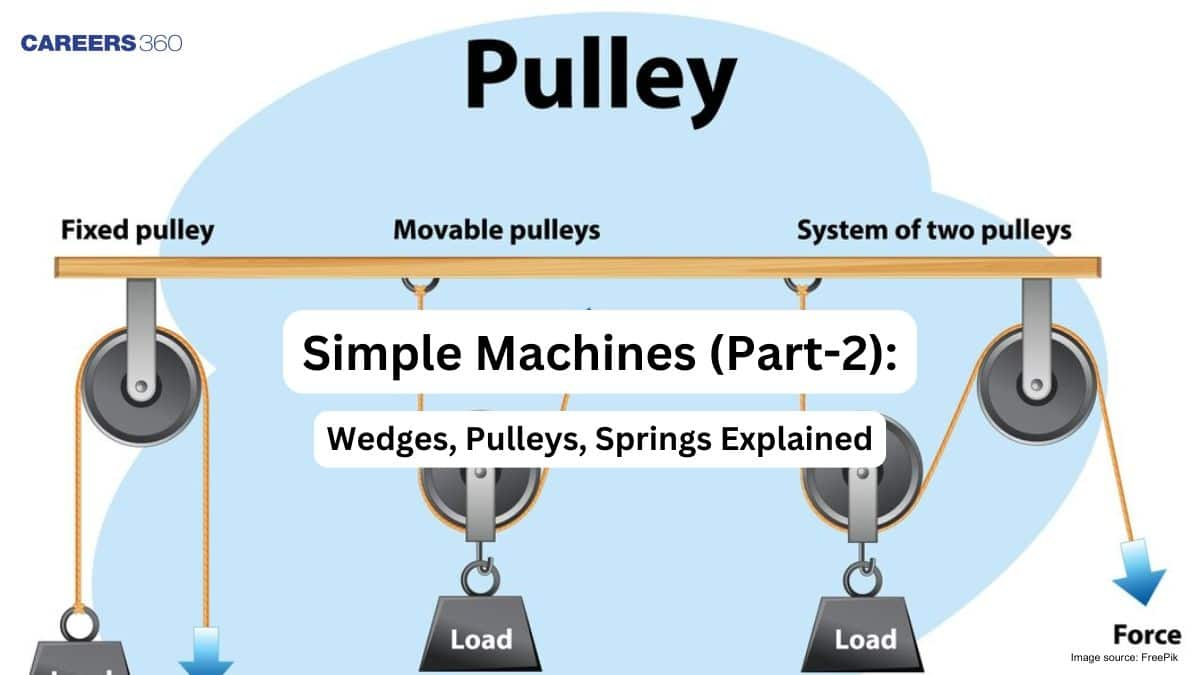
3. WEDGES
Students can go through the detailed understanding of the concept and get an understanding of what can be asked in the design entrance exams to score high.
3a. Introduction
A wedge is a sharp shape inspired by a triangle as a tool of two inclined planes attached back to back. It helps split, cut and lift objects by transferring the force applied to its blunt side perpendicular to its slanted surfaces. The wedge can exert a large force on an object when it is driven into it, making it useful for tasks like splitting wood or cutting through materials. The mechanical advantage of a wedge is determined by its ratio of wedge’s length to width.
The sharper side of the wedge is inserted into the material when force is applied to the wedge's blunt side. The object/given material splits from the point of insertion of the wedge for the force being diverted sideways. Below the figure and formula, we will understand the Wedge’s Mechanical Advantage and working mechanisms.
Mechanical Advantage (MA) = [ Length of Wedge(L) / Width of Wedge (W) ]

Note: A Thinner wedge, since it applies more force to the material being split, a longer, thinner wedge has a higher mechanical advantage.
3b. Application
Since Wedges can split and cut materials, wedges are frequently utilized in a variety of applications, as discussed below through the examples :
Axes and hatchets: These are used to break logs, large chunks of wood, and other forced-based splitting of the wood.
Knives: These are used in the shared kitchen to split and cut vegetables and meat.
Chisels: These simple tools help cut and split metalworking, stone carving, and woodworking, as seen in everyday life.
Nails and staples: use the principles of wedges to join two pieces of wood.
3c. Advantages
Efficiency: The ability to split and cut materials with little force.
Versatility: Useful for a variety of applications from household to everyday life.
Simplicity: It is simple to use and application.
Related Articles:
These are some of the topics that are generally also asked in DAT exams. Students can go through for their design entrance exam preparations.
4. PULLEY
In order to achieve a good score on the design entrance tests, students are advised to thoroughly comprehend the concept given below in details to crack the exam.
4a. Introduction
A pulley is fundamentally a wheel-based mechanism that grooves along its edges to allow a cable or rope to pass through. When a combination of pulleys is utilized in a system, they offer a mechanical advantage in addition to being used to shift the direction of a force and, thus, make the lifting easier, providing a mechanical advantage. A large amount of load can be lifted and moved with less effort if a combination of pulleys is designed to provide the mechanical advantage.
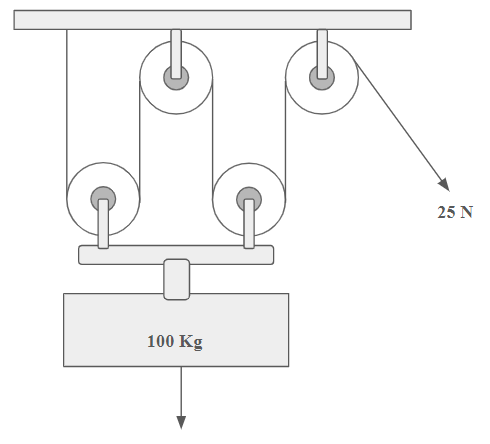
Note: It is simple to lift or move large objects when a pulley is used because it reverses the direction of the force applied to the rope or cable, which is called a block and tackle system. A block and tackle system increases mechanical advantage by combining several pulleys, so a smaller input force may raise a more significant load. The mechanical advantage of the pulleys is the ratio of Load to Efforts
Mechanical Advantage (MA) = [ Load/Effort ]
When force is applied to one side of the pulley system (typically pulling a rope), the load is lifted or moved on the other side.
The mechanical advantage increases with the number of pulleys used in the system, making it easier to lift heavier objects with less effort.
Different Types of Pulleys
Fixed Pulley: The pulley reverses the direction of applied force while the wheel remains fixed in place. A single fixed pulley offers no mechanical advantage.
Moveable Pulley: By moving with the weight, the wheel lessens the force required to raise the load. A single moving pulley offers a two-fold mechanical benefit.
A compound Pulley is a set of fixed and moveable pulleys that spreads the load over several ropes to provide a greater mechanical advantage.
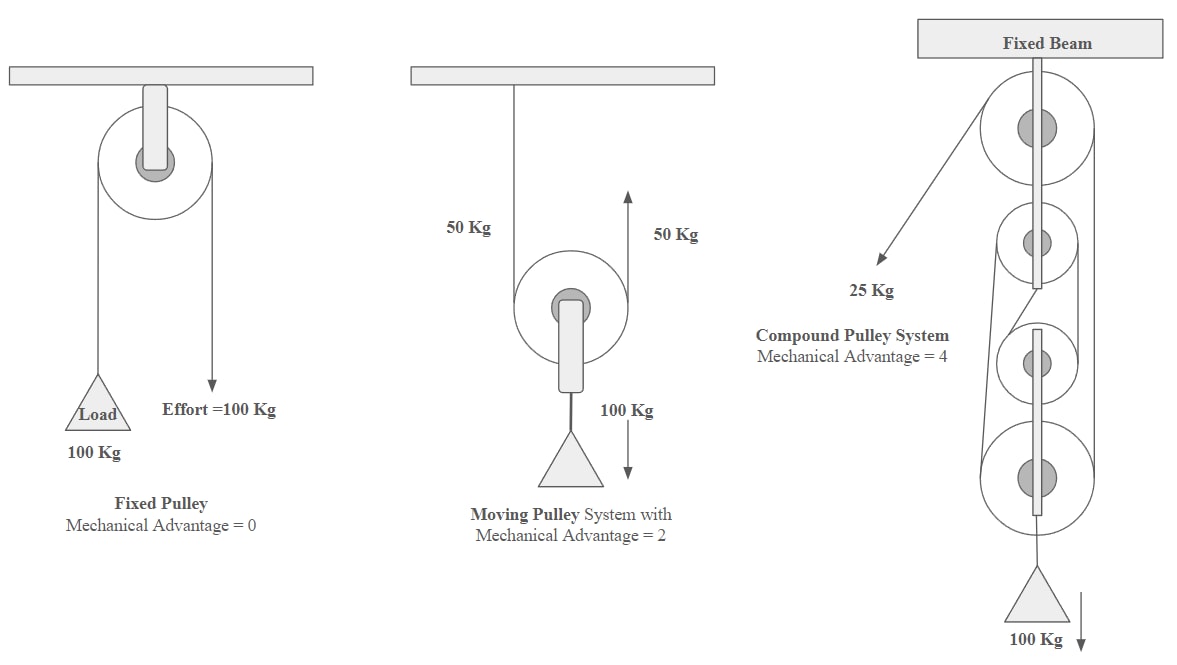
4b. Application of Pulleys
Pulleys are used in several applications, notably for lifting and moving large loads from one place to another.
Cranes: A large machine that lifts heavy masses to the desired locations using a combination of motor-controlled pulleys to achieve the task.
Elevators: Elevators in the building use the pulleys for operation.
Flagpoles: Are operated for lowering and raising the poles using a combination of pulleys.
4c. Advantages
Mechanical Advantage: Drastically reduce the force required to raise heavy loads.
Versatility: It can be used in a number of applications with minor or no changes in the operation principle to achieve a variety of results related to lifting.
Direction Change: It is a crucial feature where in many applications, the direction of force is reversed as per requirements.
Sample Questions
Q1: Which Weight requires the lesser force to move?
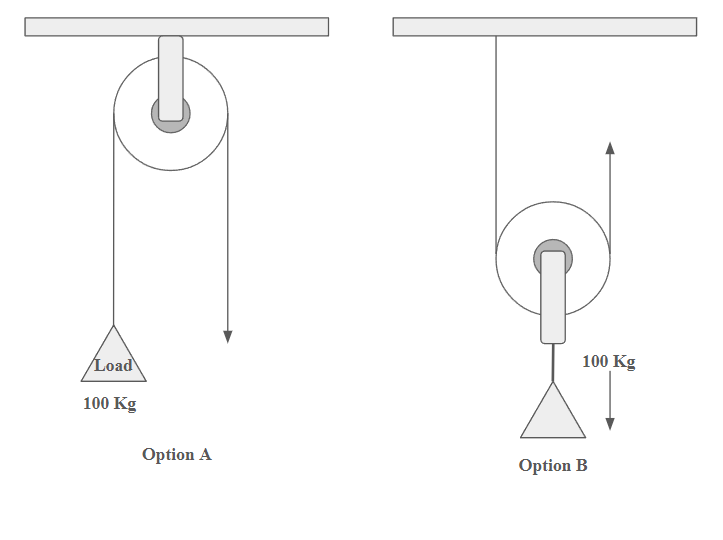
Answer: B
(For a Mechanical Advantage of 2, the force required in option B is half the load, i.e. 50kg )
Q2: Calculate the effort required to lift the weight of 100 kg for a combination of pulleys, as shown below.
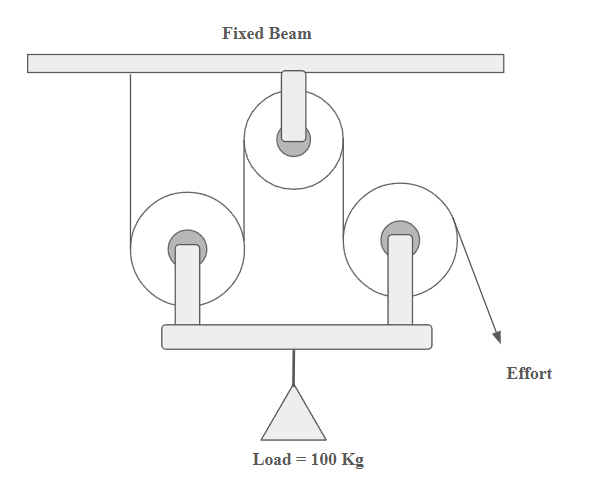
Solution:
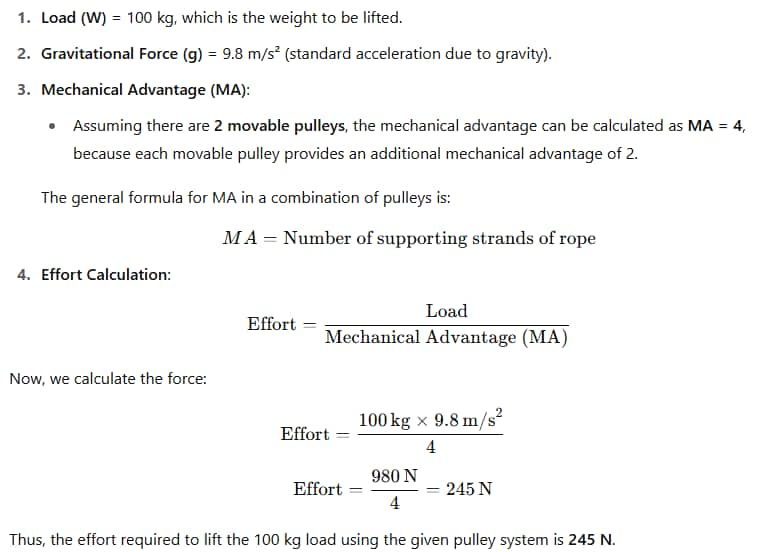
Also check:
Students can also go through to these some of the related topics that are generally asked for their design entrance exam preparations.
5. SPRINGS
Springs are mechanical components with energy storage and release capabilities. They are made of elastic materials and revert to their original configuration when compressed, stretched, or twisted. Springs are used in many applications to absorb shock, store energy, and maintain force.
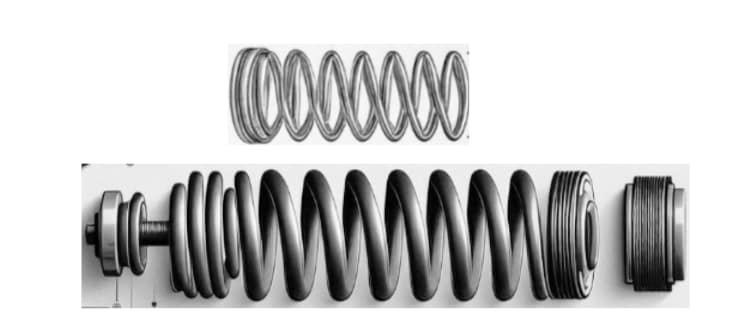
Working Principle: Hooke's Law
Hooke’s Law: Springs work according to Hooke's Law, which states that the force exerted by a spring is directly proportional to its displacement from the rest position, provided the elastic limit is not exceeded.
F(Force) = kX
k = Spring Constant (i.e. Stiffness of Spring)
X = Displacement of Spring
5a. Combination of Springs
For a combination of more than one spring, the springs can be arranged in Series or Parallel with different responses to loading conditions.
Different Loading Conditions
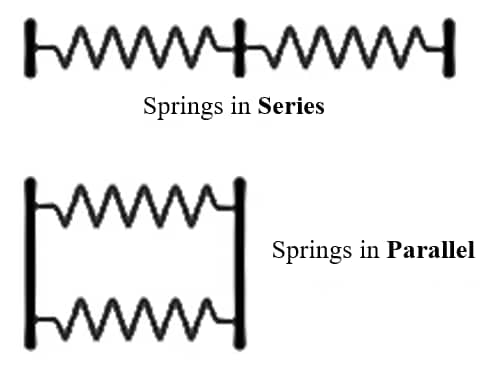
For Series Combination of Springs :
Springs are in series when they are joined end to end. Consider that you have two springs connected in succession, like in this example:
If you pull on the free end of Spring 2, the force you apply is the same on both springs. However, the total stretch (deformation) of this combined system is the sum of the stretches of each spring. Therefore, if Spring 1 stretched by 2 cm and Spring 2 stretched by 3 cm, the total stretch is calculated as follows :
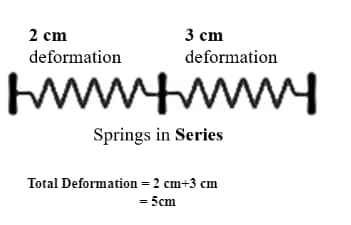
Parallel Combination of Springs :
Springs are placed in parallel when they are joined side by side of each other as shown in the image below. Consider that you have two springs with their ends connected to the same points, as shown below.
For such a combination If you pull on both springs simultaneously, they will stretch by the same amount. However, the total force the combined springs can handle is the sum of each spring's forces. So, if Spring 1 can handle a force of 5 N (newtons) and Spring 2 can hold a force of 10 N, the system can handle 15 N for equal displacements.
5b. Different Types of Springs
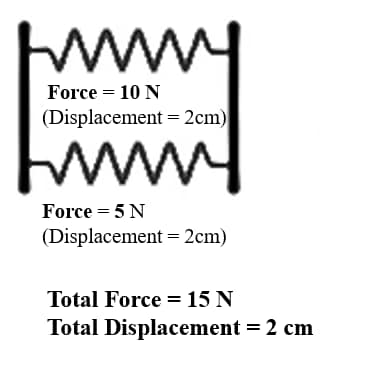
Compression-Based Springs: Designed to withstand compressive loads and expand back to their initial length upon release of the force applied.
Extension-Based Springs: Made to withstand tensile stresses and revert to their initial length upon removing the loading conditions.
Torsional Springs: Manufactured to withstand twisting pressures and revert to their initial configuration upon force release.
Constant Force Springs: Provide a continuous force for a range of motion restricting the free play.
Sample Questions
Q1: A force of 10 Kg compresses the springs attached in series by 5 cm. What would be the displacement of the two springs in parallel when an equal load compresses the springs in parallel?
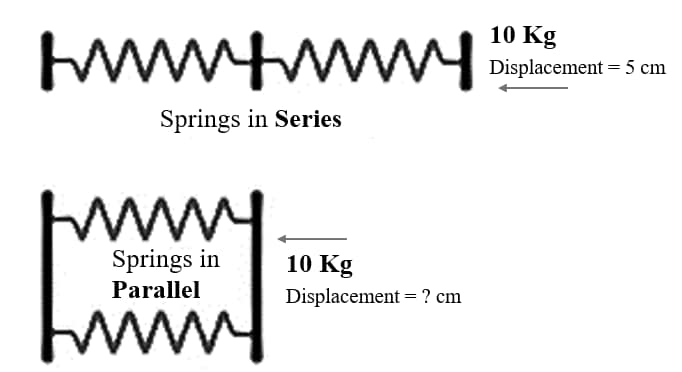
Solution:
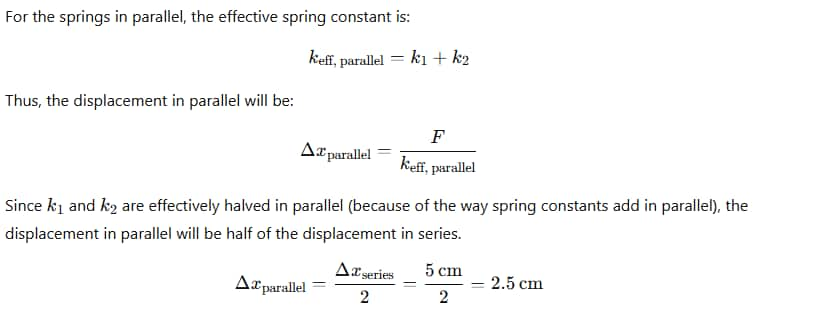
When the same 10 kg force is applied to the springs in parallel, the displacement will be 2.5 cm.
Conclusion
Wedges are modifications of inclined planes that help in cutting, splitting, and securing objects, making tasks like chopping wood or holding doors easier. Pulleys provide a mechanical advantage by changing the direction of force, making it possible to lift heavy loads with less effort—whether it’s in construction cranes, flagpoles, or gym machines. Springs, on the other hand, store and release energy, providing flexibility and shock absorption in devices like car suspensions, mattresses, and clocks.
Frequently Asked Questions (FAQs)
A fundamental ability for any design professional, mechanical aptitude assesses your capacity to apply scientific concepts to real-world scenarios. It guarantees that students may create items that are not only aesthetically pleasing but also useful and mechanically efficient.
A single fixed pulley is a modified first-class lever. This pulley's axle serves as the fulcrum point. Similarly, a single moveable pulley is a second-class lever. In this instance, the pulley's fulcrum is located where the supporting rope contacts the pulley at one end of the rope or wire.
The length-to-breadth ratio of a wedge determines its mechanical advantage. Because a longer, narrower wedge exerts a greater force on the split material, it has a higher mechanical advantage in comparison to the wedge with a larger width.
The three primary types of pulleys as discussed are compound pulleys, which are combinations of the fixed and movable pulleys to provide a large mechanical advantage. The moveable pulleys have a mechanical advantage of two contrary to the fixed pulleys, and have no mechanical advantage, only they change the direction of Force.
- Axes and hatchets: These are used to break logs, large chunks of wood, and other forced-based splitting of the wood.
- Knives: These are used in the shared kitchen to split and cut vegetables and meat.
- Chisels: These simple tools help cut and split metalworking, stone carving, and woodworking, as seen in everyday life.
- Nails and staples: use the principles of wedges to join two pieces of wood.